Valdivian Barberry Berberis valdiviana

ABOUT
Berberis valdiviana, commonly known as Valdivian barberry, is an evergreen shrub which is noted for its dense and spiny foliage. The leaves are dark green, glossy, and have a leathery texture with spiny margins, similar to those of a holly. They are arranged in clusters along the branches. The plant bears striking yellow flowers arranged in drooping racemes, which contrast beautifully against the dark foliage. These flowers later give way to small, oval-shaped berries that are typically a deep red color when ripe. The Valdivian barberry’s branches are stiff and the overall form is upright and bushy with a dense branching pattern. The bark is brownish-gray, lending an aged appearance to the shrub. The plant's thorny nature makes it a good choice for a defensive hedge or barrier plant. The visual appeal of the Valdivian barberry is complemented by its capacity to thrive in various conditions, making it not just ornamentally pleasing but also adaptable to different environments.
About this plant
 Names
NamesFamily
Berberidaceae
Synonyms
Valdivian Barberry
Common names
Berberis valdiviana
 Toxicity
ToxicityTo humans
Berberis valdiviana, commonly known as Valdivian barberry, is not widely recognized for significant toxicity to humans. However, some members of the Berberis genus contain alkaloids that can be harmful if ingested in large quantities. While reports specifically focusing on Valdivian barberry are limited, ingesting parts of plants containing such alkaloids could potentially cause gastrointestinal discomfort, nausea, vomiting, dizziness, or confusion. It's generally advised to avoid consuming parts of ornamental plants such as Valdivian barberry due to the potential for adverse effects.
To pets
Valdivian barberry is not known for being particularly toxic to pets. However, like with humans, some plants in the Berberis genus contain alkaloids that may be harmful if ingested in large quantities. These compounds could lead to gastrointestinal upset in pets, including symptoms like vomiting and diarrhea. While Valdivian barberry toxicity is not well-documented, it's a good practice to prevent pets from consuming garden plants as they may contain substances that could lead to negative health consequences.
 Characteristics
CharacteristicsLife cycle
Perennials
Foliage type
Evergreen
Color of leaves
Green
Flower color
Yellow
Height
15 feet (4.57 meters)
Spread
10 feet (3.05 meters)
Plant type
Shrub
Hardiness zones
7
Native area
Chile
Benefits
 General Benefits
General Benefits- Ornamental value - Berberis valdiviana, commonly known as Valdivian Barberry, is appreciated for its lush evergreen foliage and striking yellow flowers which can enhance the aesthetic of gardens and parks.
- Habitat for wildlife - It provides shelter and nesting sites for various bird species, as well as a source of food when it bears fruit.
- Drought resistance - This plant is known for its ability to withstand periods of low water availability, making it suitable for xeriscaping and drought-prone regions.
- Erosion control - The root system of Valdivian Barberry helps to stabilize soil and prevent erosion on slopes and banks.
- Privacy hedge - Due to its dense foliage, it can be effectively used as a hedge to create privacy screens in residential and commercial landscapes.
- Low maintenance - It requires minimal care once established, making it a convenient choice for gardeners of all skill levels.
 Medical Properties
Medical PropertiesThis plant is not used for medical purposes.
 Air-purifying Qualities
Air-purifying QualitiesThis plant is not specifically known for air purifying qualities.
 Other Uses
Other Uses- Berberis valdiviana, commonly known as Valdivian barberry, can serve as a natural dye source, with its roots and bark being used in traditional textile coloring processes.
- The wood of the Valdivian barberry is hard and can be used for creating small wooden tools and intricate wood carvings.
- In some cultures, the thorns of Valdivian barberry have been used as needles for traditional embroidery or for the creation of fish hooks.
- The bright, attractive berries can be used for ornamental purposes in floral arrangements and wreaths.
- Valdivian barberry can be planted as a living fence or hedge, taking advantage of its dense growth and thorny branches to deter trespassers and animals.
- The plant can play a role in erosion control due to its sturdy root system that helps to stabilize the soil.
- Gardeners use Valdivian barberry to attract pollinators like bees and birds, thereby promoting the health of the entire garden ecosystem.
- Its ability to adapt to various soil conditions makes it useful for land reclamation projects and in the restoration of disturbed sites.
- Valdivian barberry's dense foliage can serve as a shelter for small wildlife, providing a habitat for beneficial insects and small birds.
- In some regions, the leathery leaves have been used as makeshift bookmarks or as a natural decorative element in crafting.
Interesting Facts
 Feng Shui
Feng ShuiThe Berberis is not used in Feng Shui practice.
 Zodiac Sign Compitability
Zodiac Sign CompitabilityThe Berberis is not used in astrology practice.
 Plant Symbolism
Plant Symbolism- Resilience: Berberis valdiviana, commonly known as Valdivian barberry, is adept at surviving in tough conditions, symbolizing the ability to endure and thrive through adversity.
- Protection: This plant is known for its thorny branches, which historically have been used as a natural barrier, representing safeguarding and defensiveness.
- Sharpness: The sharp thorns of the Valdivian barberry can symbolize clarity, precision, and the idea of being "sharp-witted" or "keen."
 Water
WaterValdivian Barberry prefers consistent moisture, so water it when the top inch of soil feels dry to the touch, usually about once a week. During the hotter months, you may need to water it more frequently to maintain moist soil, possibly up to twice a week. In cooler climates or during rainy periods, reduce watering to prevent waterlogging. Each watering session should provide enough water to soak the soil around the roots, which typically equates to 1-2 gallons, depending on the size and maturity of the plant and the environmental conditions.
 Light
LightValdivian Barberry thrives in full sun to partial shade. Ideally, it should be positioned where it can receive at least six hours of sunlight daily. However, if you're in an area with very hot summers, providing afternoon shade can prevent the leaves from scorching, so a spot with morning sun and afternoon shade would be perfect for this plant.
 Temperature
TemperatureValdivian Barberry is hardy and can tolerate a wide range of temperatures, but it performs best in areas where the average temperature ranges between 60°F and 75°F. It can withstand minimum temperatures down to about 20°F and maximum temperatures up to 90°F. To ensure healthy growth and flowering, avoid placing it in areas where extreme temperatures below or above this range might occur.
 Pruning
PruningValdivian Barberry benefits from regular pruning to maintain its shape and encourage new growth. The best time for pruning is late winter or early spring before new growth starts. It's customary to prune this plant once a year to remove any dead or diseased branches and to thin out overcrowded areas to increase light penetration and air circulation within the shrub.
 Cleaning
CleaningAs needed
 Soil
SoilValdivian Barberry prefers well-draining soil with a mixture of loam, peat, and sand which helps mimic its native habitat. The soil pH should lean towards acidic, ranging from 5.0 to 6.5 for optimal growth.
 Repotting
RepottingValdivian Barberry should be repotted every 2-3 years to replenish the soil and provide room for growth. Younger, actively growing plants may require more frequent repotting.
 Humidity & Misting
Humidity & MistingValdivian Barberry thrives in moderate to high humidity levels, ideally around 60-70%, which helps reflect its natural cloud forest conditions.
 Suitable locations
Suitable locationsIndoor
Ensure bright indirect light, cool temps, and high humidity.
Outdoor
Plant in partial shade, protect from strong winds and harsh sun.
Hardiness zone
7-10 USDA
 Life cycle
Life cycleBerberis valdiviana, commonly known as Valdivian barberry, begins its life as a seed that germinates in moist, well-drained soil, preferably in partial shade. As a seedling, it starts to develop roots and a shoot that will grow into a woody stem. The juvenile phase follows, characterized by the growth of spiny evergreen leaves and a sturdy branching structure. The plant reaches maturity when it starts flowering, producing yellow flowers that attract pollinators like bees and eventually give way to small, purple-black berries, which are dispersed by birds and mammals. Maturity also includes the continuous production of woody stems and foliage, creating a dense, shrubby form that can endure for many years. Finally, as an older plant, Valdivian barberry will enter a stage of senescence where growth slows and the plant invests less in reproduction, eventually leading to its natural death.
 Propogation
PropogationPropogation time
Spring-Early Summer
The most popular method of propagation for the Berberis valdiviana, commonly known as Valdivian Barberry, is through semi-hardwood cuttings. This technique usually takes place during the late summer. To do this, gardeners select healthy, semi-ripe stems of the current year's growth and make cuttings of about 4 to 6 inches long. The leaves on the lower half of the cutting are removed, and the cut end may be dipped in a rooting hormone powder to encourage root development. Then the cutting is planted in a well-draining soil mixture. It's important to maintain consistent moisture, without waterlogging, and to provide a good balance between light and humidity. Under optimal conditions, the cuttings will develop roots and can then be transplanted to their permanent location.

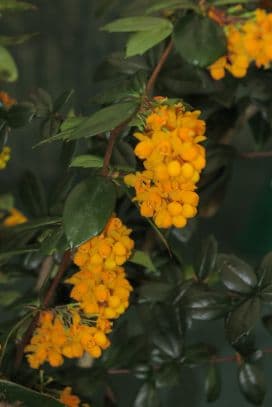
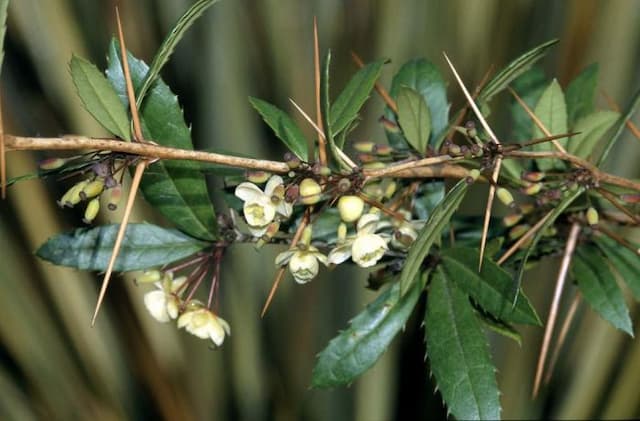
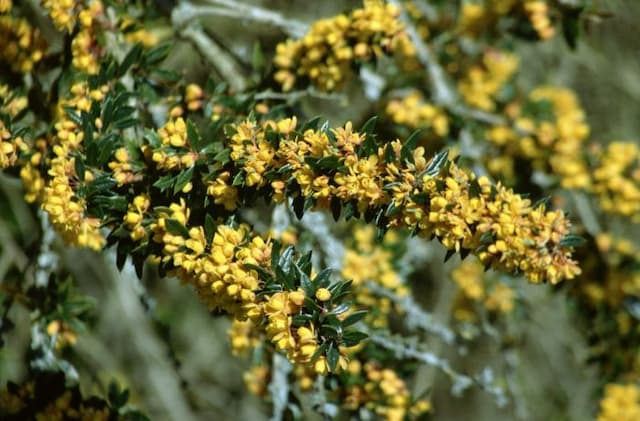
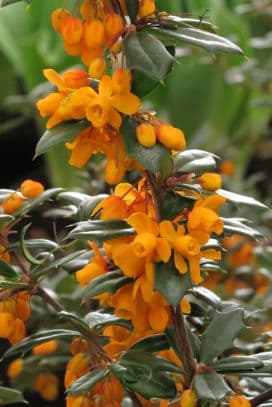
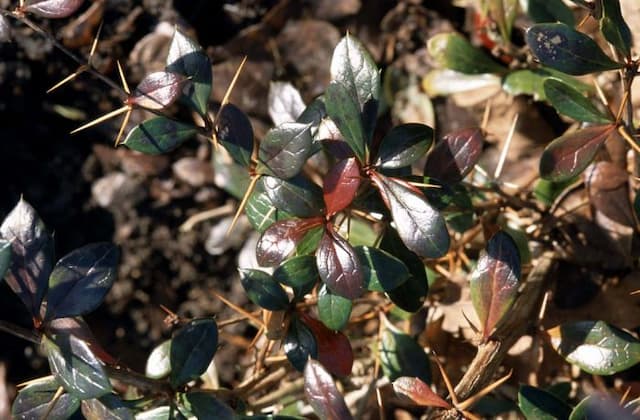


![Japanese barberry [Bonanza Gold]](/_next/image?url=https%3A%2F%2Fplants-admin.emdemapps.com%2Fimages%2Fplants%2F%2Fimages%2F604b5385e413f.png&w=640&q=75)
